By the end of this post, your knowledge of vertical and horizontal integration will improve. You will get better at decisions on mergers and acquisitions for business growth.
Vertical integration and horizontal integration are among the key strategies followed by businesses. Let me show you how you can use these strategies for scaling your business.
- What is Vertical Integration?
- Horizontal Integration in Strategic Management
- Difference between Horizontal and Vertical Integration
1. What is Vertical Integration?
Let me explain. Through vertical integration, a company expands the production vertical via acquisitions. This strategy helps the firm to gain more control over the supply chain. The expansion can be of any division from manufacturing the products to end sales.
Vertical integration can be upstream or downstream in the supply chain. Here’s an illustration of what I mean: 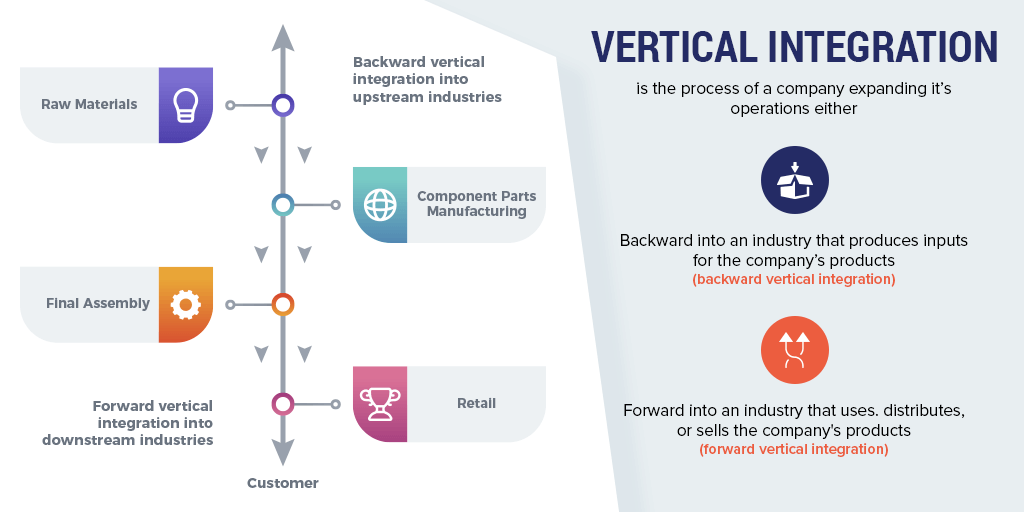 Extra Insight:
Extra Insight:
With vertical integration business acquisitions, you can create a monopoly known as Vertical Monopoly.
Need help to improve your existing processes with cutting-edge technology?
1.1 Types of Vertical Integration strategies
As I mentioned earlier, vertical integration can be in the forward or the backward direction.
Here is something I want to share with you:  There’s a nifty trick you can use for improving your supply chain:
There’s a nifty trick you can use for improving your supply chain:
Add custom integrations in your e-commerce store to improve your processes.
Here's an example of our client Animation shops:
We added a Stamps.com shipping integration to the client's existing system. The integration helped to sort preferred shippers as per shipping price and destination.
Extra Insight:
In my experience, decision-making for vertical integration is critical.
My suggestion:
Check the costs of integration and the competitive advantage that you’ll gain from vertical integration.
Are you looking for solutions to gain a competitive edge online?
1.2 Advantages of Vertical Integration
Have you ever wished to have greater control over your supply chain? You can fulfill your wish with vertical integration.
If you are serious about vertical integration, here are five advantages you can enjoy:
- Offer high-quality products at low costs to your consumers.
- You can predict your demand with more accuracy as you have more control in the business.
- No need to be dependent on suppliers for meeting market demand.
- You can gain a higher market share in your industry.
- Get more control over the processes and run them as per your business goals.
Extra Insight:
Don't get attracted to the benefit of gaining control. Make sure that your vertical integration is profitable for your business.
Are you looking for strategies to improve your e-commerce profitability?
1.3 Disadvantages of vertical integration
Not to say everything will be sunflowers and daffodils here. Let me share a few disadvantages of vertical integration.
- Your responsibility will increase. You'll have to ensure that you can meet the demand.
- Be careful if gain too much control over market conditions. Anti-trust regulators can come after you for influencing the market.
- You may need enormous investments for strategic business acquisitions.
- What if you are unable to manage the integrations? Your retail business operations will get affected.
 Extra Insight:
Extra Insight:
Keep in mind:
You will need extra investments to run the acquired businesses and maintain profitability. Before investing in vertical integration and horizontal integration, check the expenses you will have to incur later.
Want to reduce expenses with technology upgrades?
1.4 Examples of Vertically Integrated Companies
One of the excellent examples of vertical integration is Luxottica.
You may have heard about eyewear brands such as Oakley, Ray-Ban, Prada, Chanel, and many others. But what you may not know if that Luxottica owns all these eyewear brands.
Interesting, right?
Luxottica has around 9,100 stores around the world. Using the vertical integration strategy, the company controls product design, development, and manufacturing. The company manages operations via its facilities in Italy, China, Brazil, U.S., Japan, and India.  Extra Insight: For the record, other than full vertical integration, you can use different strategies. Quasi-vertical integration, spot contracts, and long-term contracts are other degrees of vertical integration.
Extra Insight: For the record, other than full vertical integration, you can use different strategies. Quasi-vertical integration, spot contracts, and long-term contracts are other degrees of vertical integration.
Are you interested in a scalable e-commerce solution for your strategic vertical integration?
2. Horizontal Integration in Strategic Management
Before I jump into the details, what is horizontal integration?
It is a strategy to reduce competition by capturing the vast majority of the market.
You may think there must be some hidden catch, right? Not really.
Using horizontal integration strategy, companies try to acquire other companies at the same level of the value chain.
So, what’s the purpose of horizontal integration?
- To increase the capacity of the business
- To reduce risks
- To enter new markets
- To grow the market share
Extra Insight:
Here’s one scenario when horizontal integration can be useful. If you feel that you can gain more value from a business after integration, think about acquiring it.
Do you need help with unifying your brands after an acquisition?
2.1 Advantages of Horizontal Integration
So, when is horizontal integration attractive for a business?
If factors are affecting the sustainability of a business, merging with a competitor can be more valuable to both companies. The horizontal integration will enable knowledge-sharing and increase in profitability.
Here’s something else:
By merging with a competitor, you can minimize your competition and increase your market share.
Extra Insight:
Be careful of your mergers and acquisitions for vertical integration and horizontal integration. It should result in a monopoly that is per applicable laws.
Stay competitive with cost-effective technology upgrades?
2.2 Disadvantages of horizontal integration strategy
It’s no secret that there are disadvantages of Horizontal integration as well.
Let me share some of the disadvantages of horizontal integration with you.
- You have less flexibility when you merge with another firm.
- If the two merging firms have diverse policies, then there can be challenges later.
- Legal issues can become a barrier in Horizontal integration of companies.
Extra Insight:
Here’s one more cold, hard truth:
You cannot merge with a company if your merger leads to enormous market control.
In 2015, the horizontal integration of Sysco’s with US Foods did not happen. Why? The federal judge ruled against the deal. Their merger would have controlled 75% of the U.S. food services sector. It meant that an unhealthy competition in the market would have surfaced.
Explore smart automation solutions to follow compliance in your business?
2.3 Horizontal Integration examples
Pfizer became one of the world’s leading pharmaceutical companies through horizontal integrations.
Let me show you how: 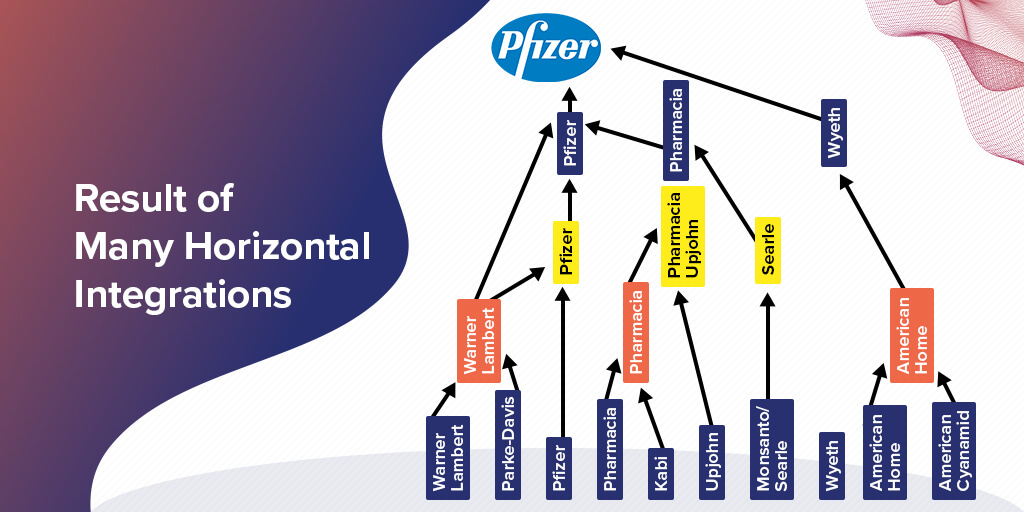 Some of the notable horizontal integration examples include mergers such as:
Some of the notable horizontal integration examples include mergers such as:
- AB-InBev acquisition of SAB Miller – 2016
- Heinz merger with Kraft – 2015
- Marriott Hotels merges with Sheraton – 2015
 Extra Insight:
Extra Insight:
Merge with competitors horizontally to get a competitive advantage on economies of scale.
Scale your business with the right technology integrations.
3. Difference between Horizontal and Vertical Integration
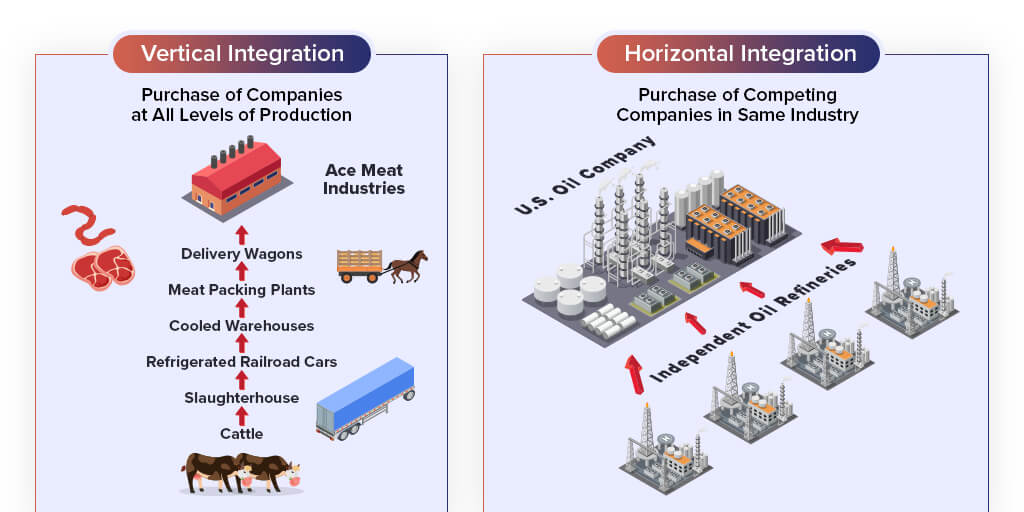 I don’t need to tell you that vertical integration and horizontal integration can be effective business strategies to improve your ROI.
I don’t need to tell you that vertical integration and horizontal integration can be effective business strategies to improve your ROI.
You already know about the advantages and disadvantages of vertical and horizontal integration. So, which one should you choose?
You can choose an integration strategy as per your business goals.
I saved the best for last.
One more thing, here’s how Luxottica benefited from a mix of vertical as well as horizontal acquisitions: 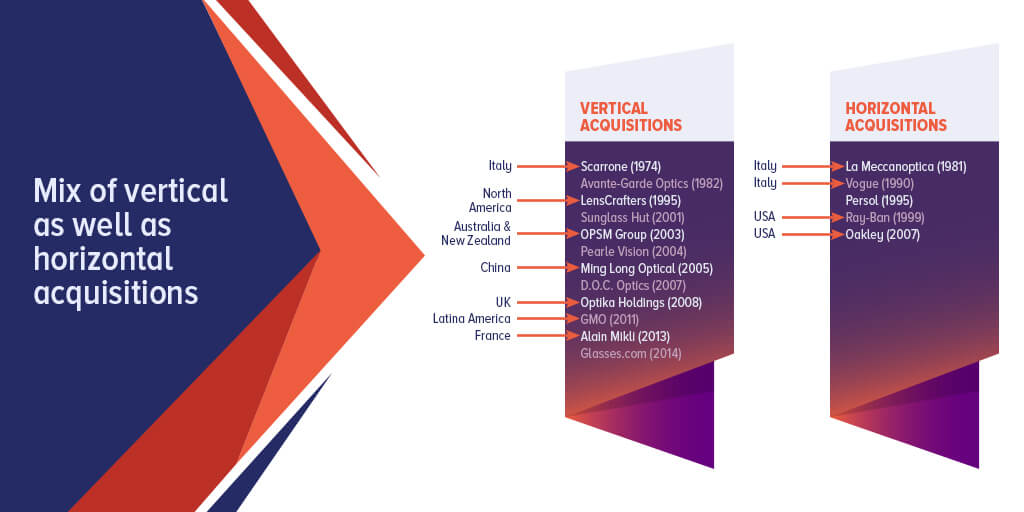 But here’s the deal: Don’t rely on your intuition when it comes to integration strategies.
But here’s the deal: Don’t rely on your intuition when it comes to integration strategies.
To help you decide, here’s a comparison chart of vertical and horizontal integration: 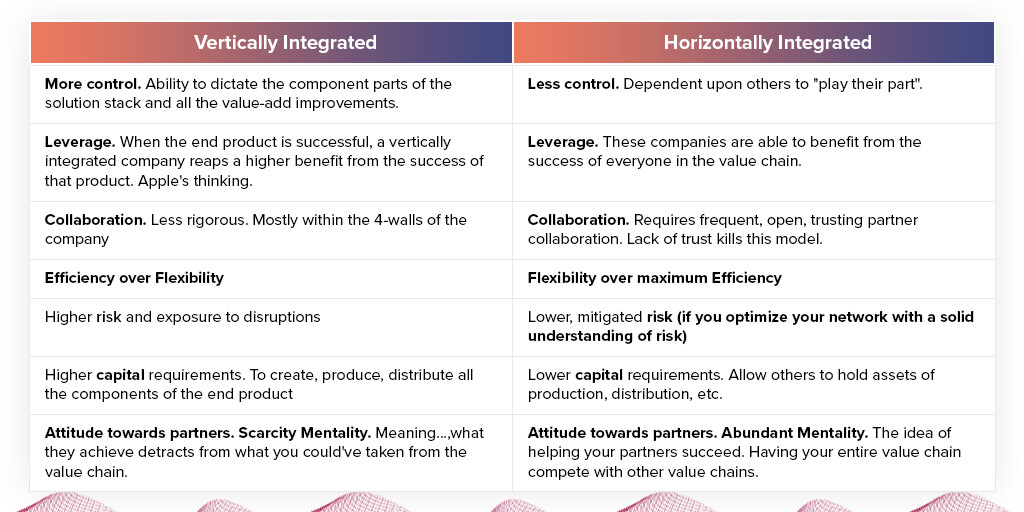 Extra Insight:
Extra Insight:
Also, here is a valuable insight on integration from Gary Hamel, a management expert based in the U.S. 
Smart solutions can solve your problems as you grow.
Conclusion
To sum it up, you can choose vertical integration and horizontal integration to suit your business needs. Evaluate the risks and the benefits before you jump to any decisions. Make sure to gain a competitive advantage with profitability in view.
If you want to revisit some of the points covered in this post, here’s a quick recap:














